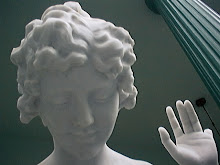Yesterday we wandered through the immense and baffling halls of a faux english manor set in one of our most expensive intown neighborhoods. The collected possessions of the couple that built the house in the 1990's were on display for purchase, although few could afford anything but a soapdish. Tiny china dogs were 85 dollars, sets of silver many times more than that. Paintings, rugs, old books, objets d'art, humidors, writing desks, grand tables... even the mundane objects were pricey. The local football team logo was evident everywhere, suggesting a hospitable connection with the two rooms with wet bars. Collections of figurines of all kinds began to blur together until my companion pointed out the strange pairs of white animals, some with baskets in their mouths, others with smaller offspring.
Were they lions, sheep, lambs? They dated from the 1830's and had funny, kabuki-like expressions with painted arched eyebrows and dotted noses and red lips, their hair falling in two puffy billows on either side of their heads. What could they be?

A herd of them populated every surface of the master bedroom. On the bedside tables they held baskets of baby versions in their mouths while holding up the lampshades. What is the significance of these creatures? What power did their owner endow them with? I would have had a hard time sleeping in the room with them looking at me.

Now that I know they are poodles, Staffordshire poodle figurines, to be exact, I began to feel the tug of their strange magnetism and did a little research. I have now learned that these figurines have what is referred to as "parsley", "spaghetti," or "confetti" style hair, and that the males are distinguished with a mustache. (Note the poodle on the top left, above.) They cost upwards of $180 dollars apiece.
According to
www.poodlehistory.org:
Staffordshire (1840-1900) and Rockingham (1826-1842) figurines, and etc. Poodles as well as spaniels were among the favorite subjects for endearingly naive yet vital figurines manufactured for cottage mantlepieces.
Not unlike their chain-linked brethren from Woolworth's, they began as decor for the humbler classes. Perhaps one day 100 years from now, the libraries and master suites of the not-so-landed gentry will display matching mother and baby poodle figurines from the five and ten just as proudly, but will they resonate with such a haunting, impertinent gaze?
 Movie of Death Scene
Movie of Death Scene















